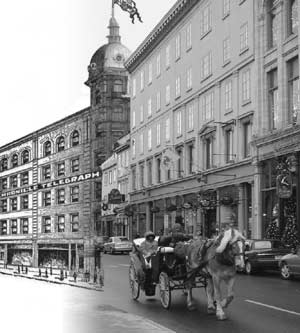A brief history of North America’s oldest newspaper, since 1764
Compiled by Charles André NADEAU
The Quebec Chronicle-Telegraph has enjoyed a long and distinguished career in Quebec City for over 250 years. It is the descendant of several newspapers published during the 18th, 19th and 20th centuries.
The first edition of The Quebec Gazette/La Gazette de Québec came off the presses on June 21, 1764. Founded by William Brown, The Quebec Gazette had 150 subscribers in 1764. It was obliged to suspend publishing briefly during the 1765 Stamp Act crisis, and again during the siege of the city by American troops in late 1775-early 1776. In spite of these interruptions, the newspaper is proud to claim that it has been in continuous operation since it was founded over 250 years ago.
Following William Brown’s death in 1789, two of his nephews, Samuel and John Neilson, managed the business.
From its founding until 1842, articles were written both in English and French and the paper was published weekly. As of January 1818, two editions per week were published. In May 1832, the publishers began to issue the paper in English on Mondays, Wednesdays and Fridays, and in French on Tuesdays, Thursdays and Saturdays.
The Quebec Gazette remained bilingual until 1842. The presence of a growing number of French newspapers in Quebec City at that time made the French editions of the Gazette unnecessary and unprofitable.
A long-time employee of the Nielsons, Robert Middleton, left The Quebec Gazette in 1847 to found The Morning Chronicle with his business partner Charles Saint-Michel.
John Neilson published The Quebec Gazette until his death in February 1848. His son John Neilson Jr. operated the paper temporarily until Robert Middleton sold his shares in TheMorning Chronicle and came back as editor and part-owner of The Quebec Gazette in 1849. Middleton bought the company the following year. This purchase marked the end of the Brown-Neilson family involvement with the newspaper.
Charles Saint-Michel sold The Morning Chronicle in 1860 to the Foote family. Following Middleton’s death in 1874, J.J. Foote acquired The Quebec Gazette and merged it with The Morning Chronicle.
A year later, James Carrel founded The Daily Telegraph. The first edition of the new sheet appeared on the streets on November 9, 1875. Unlike The Morning Chronicle, which catered to the conservative electorate, The Daily Telegraph defended popular opinion and offered a more liberal perspective.
The steady decline of the English-speaking population of Quebec City in the latter part of the 19th and early 20th century proved unprofitable to the two competing publications. On July 2, 1925, they merged. The new name chosen by the owners was The Chronicle-Telegraph. On February 5, 1934, it was renamed The Quebec Chronicle-Telegraph. The printing company was then owned by James Carrel’s son Frank Carrel and William Price, who had become a partner in 1922. The offices of the newspaper were located on Rue de Buade, at the corner of Rue Du Trésor.

In September 1949, the business moved to Rue Saint-Sacrement in the Saint-Malo Industrial Park, having been purchased the previous July by the Thomson publishing conglomerate. In November 1971, the Quebec Chronicle-Telegraph became a weekly, like its original predecessor. Herb Murphy bought the paper in the autumn of 1973.
On December 16, 1979, a group of lawyers and businessmen David Cannon, Jean Lemelin and Ross Rourke, along with broadcaster Bob Dawson, became the newspaper’s owners. On January 1, 1993, Karen Macdonald and her husband François Vézina took over. They were followed, on August 1, 2007, by Peter White and Pierre Little, and in November 2010, by Raymond Stanton and his wife, Stacie Stanton, who is the current editor and publisher.
In the course of its long career, the newspaper has occupied many buildings, from its humble beginnings on Rue Saint-Louis opposite Place d’Armes, to various places on Côte de la Montagne, to the grand building known as the palais de la presse à Québec at the corner of Rue de Buade and Rue du Trésor. Designed in 1907 by Georges-Émile Tanguay, it was built to house The Daily Telegraph. The building was home to The Quebec Chronicle-Telegraph from 1925 to 1949.
The move to the Saint-Malo industrial park in 1949 was caused by the need for additional space to accommodate larger, more modern printing presses and to provide parking facilities for the company’s vehicles and its employees. As it returned to being a weekly publication and is no longer printed in-house, the QCT, as it is familiarly known, moved to more humble facilities: a building on Avenue Holland, the premises of the former Wax Museum on Rue Sainte-Anne, a private home in Sainte-Foy, an office building on Chemin Sainte-Foy, and, most recently, an office building at 1040 Avenue Belvédère near the corner of Boulevard René-Lévesque.
The Quebec Chronicle-Telegraph is published every Wednesday and has a circulation of 2,200. On June 21, 2014, it celebrated its 250th anniversary as North America’s Oldest Newspaper.
Information about QCT archives can be found here
